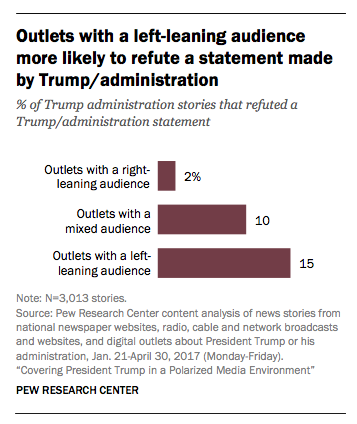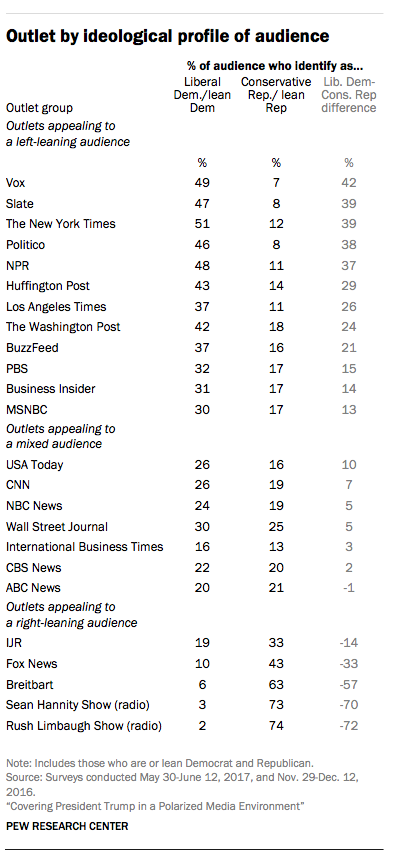Many news consumers went looking for positive or negative coverage of the new administration’s first 100 days, and boy, did they find it, according to a new study from the Pew Research Center.
It’s hardly surprising that the New York Times painted a more negative picture of Trump’s time in office than Fox News, but the contrasts were extreme.
A cluster of outlets with right-leaning audiences were at least five times more likely to carry positive assessments of the president and his administration than those that were left-leaning or mixed in their audience composition
Conversely, sites and broadcasts with left-leaning audiences were ten times as likely to run negative rather than positive assessments of the administration. In addition, direct refutations of a statement by Trump or his administration were seven times more likely to appear in the outlets with left-leaning audiences, compared to those with an audience that tilted right.
I asked Amy Mitchell, lead author of the study and director of journalism research for Pew, whether the study confirms a massive filter bubble, carrying over from the election to the governing phase of the Trump era.
 Yes and no, she said. The study did not attempt to classify the 24 outlets studied as right, left or down the middle. “We were looking at audience composition. And the degree to which Americans gravitate to news outlets that confirm their viewpoint is significant. This is solid data that what different groups hear and read is different.”
Yes and no, she said. The study did not attempt to classify the 24 outlets studied as right, left or down the middle. “We were looking at audience composition. And the degree to which Americans gravitate to news outlets that confirm their viewpoint is significant. This is solid data that what different groups hear and read is different.”
She added that despite the contrast in stories with a slant, a great many in all the media monitored were neutral. Even in the media with a right-leaning audience, only 31 percent were positive, with the balance mostly neutral and a few negative.
For purposes of the study, 3,000 stories were covered. Researches coded a given story negative or positive if it had at least twice as many statements leaning one way or another, compared with statements giving an opposing view.
The study also identified five main topics of coverage across the digital publications, cable shows and broadcasts studied that together accounted for two-thirds of the stories: the president’s political skills, immigration, appointments and nominations, U.S-Russia relations, and health care.
Pew also had similar studies from the early days of the Clinton, Bush and Obama administrations. Those were all heavy on policy issues; the Trump coverage was much more likely to be framed around his leadership and character. For the Bush and Clinton administrations, domestic issues dominated initially; foreign affairs, led by the Russia story, had a comparatively bigger role in Trump coverage.
One other element of the study was to describe the sourcing of the stories. Those with a left-leaning or mixed audience typically were much more likely to cite multiple sources, include comment from third-party groups and experts and even to cite a statement from the president or member of his administration.
A statement from the president or administration was the single most frequent source for all three of the types of outlet.
A sixth of all the stories studied referenced one of President Trump’s tweets.
Though not the point of the study, I found interesting, how audience members described their political leanings — yielding a kind of ranking from most liberal to most conservative outlets.

Among the 24 assessed, Vox and Slate had the most left-leaning audiences (49 percent and 47 percent respectively) with only single-digit percentages identifying themselves as conservative. The New York Times has 51 percent left-leaning but more (12 percent conservative) than the two digital only sites.
Others with especially left-leaning audiences included Politico, NPR and Huff Post. The mixed audience group included USA Today and the Wall Street Journal, all three broadcast networks and CNN.
Half of the 24 sites selected (essentially the most heavily trafficked with original political content) were classified as having left-leaning audiences. Even among the mixed audience sites, slightly more audience members self-identified as left-leaning than as conservative.
Pew Research classified the audiences of five of the outlets studied as having a right-leaning audience. They were in order, Rush Limbaugh’s show (74 percent), Sean Hannity’s show (73 percent), Breitbart (63 percent), Fox News (43 percent) and Independent Journal Review (33 percent)
I wondered whether the heavy representation of broadcast and cable in the right-leaning audience preferences might have skewed some of the results. Not as much as you would think, Mitchell said.
Digital platforms, including those of the five newspaper organizations studied, were more likely to include multiple sources. But as the study puts it:
“There are large differences within platforms across the outlet groupings. For number of source types, three quarters of digital stories from outlets with a left-leaning audience cited multiple sources, 17 percentage points higher than those from outlets with a right-leaning audience (58 percent). The same pattern holds for both television and radio. This suggests, then, that platform may be a small part of the story, but is not the full story. There are still decisions made within news organizations that impact the content audiences receive.”
Bottom line: The most polarized news audiences do not merely disagree about how President Trump is doing. The base of their information on what’s happening appears to be markedly different.







